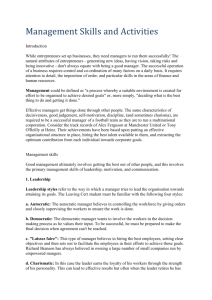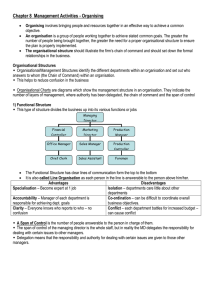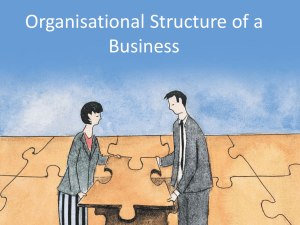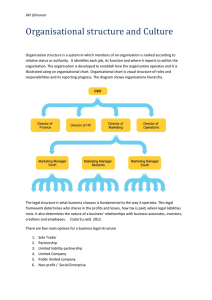Chapter 8 – Management Activities
advertisement
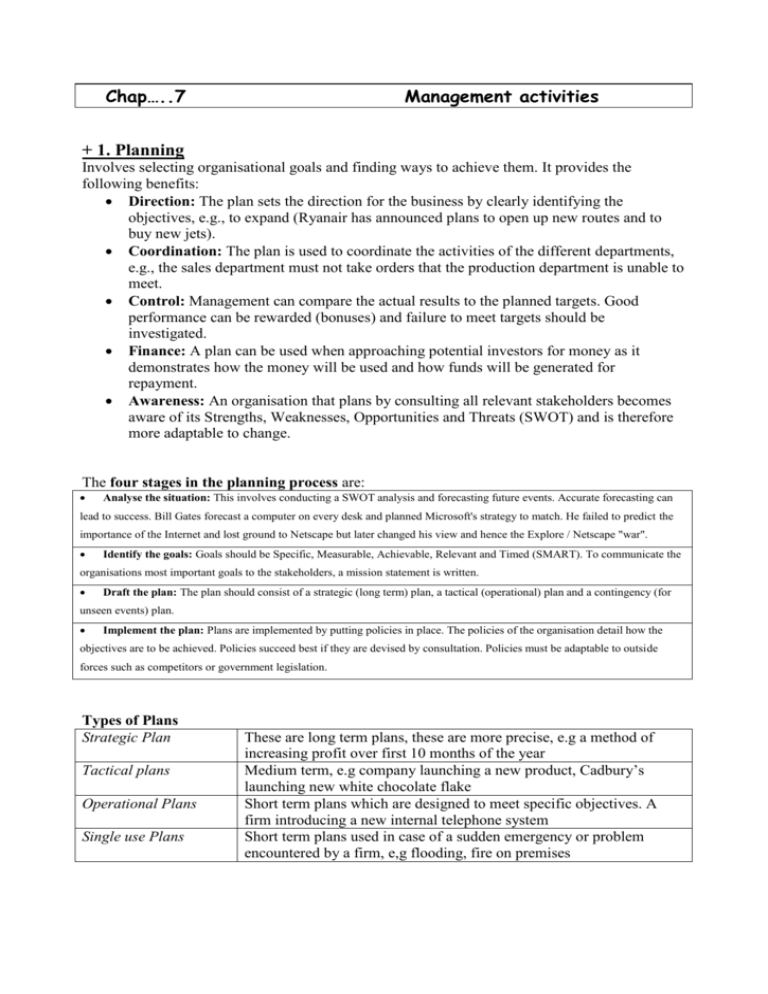
Chap…..7 Management activities + 1. Planning Involves selecting organisational goals and finding ways to achieve them. It provides the following benefits: Direction: The plan sets the direction for the business by clearly identifying the objectives, e.g., to expand (Ryanair has announced plans to open up new routes and to buy new jets). Coordination: The plan is used to coordinate the activities of the different departments, e.g., the sales department must not take orders that the production department is unable to meet. Control: Management can compare the actual results to the planned targets. Good performance can be rewarded (bonuses) and failure to meet targets should be investigated. Finance: A plan can be used when approaching potential investors for money as it demonstrates how the money will be used and how funds will be generated for repayment. Awareness: An organisation that plans by consulting all relevant stakeholders becomes aware of its Strengths, Weaknesses, Opportunities and Threats (SWOT) and is therefore more adaptable to change. The four stages in the planning process are: Analyse the situation: This involves conducting a SWOT analysis and forecasting future events. Accurate forecasting can lead to success. Bill Gates forecast a computer on every desk and planned Microsoft's strategy to match. He failed to predict the importance of the Internet and lost ground to Netscape but later changed his view and hence the Explore / Netscape "war". Identify the goals: Goals should be Specific, Measurable, Achievable, Relevant and Timed (SMART). To communicate the organisations most important goals to the stakeholders, a mission statement is written. Draft the plan: The plan should consist of a strategic (long term) plan, a tactical (operational) plan and a contingency (for unseen events) plan. Implement the plan: Plans are implemented by putting policies in place. The policies of the organisation detail how the objectives are to be achieved. Policies succeed best if they are devised by consultation. Policies must be adaptable to outside forces such as competitors or government legislation. Types of Plans Strategic Plan Tactical plans Operational Plans Single use Plans These are long term plans, these are more precise, e.g a method of increasing profit over first 10 months of the year Medium term, e.g company launching a new product, Cadbury’s launching new white chocolate flake Short term plans which are designed to meet specific objectives. A firm introducing a new internal telephone system Short term plans used in case of a sudden emergency or problem encountered by a firm, e,g flooding, fire on premises +2. Organising Means bringing people and resources together to achieve a common objective. An organisational structure identifies the different functions in an organisation and sets out the power structure. This can be represented in an organisational chart. The simplest organisational chart is the functional structure, which divides a business according to management functions at senior, middle management and junior levels. There are three layers of management in this chart: top, middle, and junior management. It indicates where authority and responsibility have been delegated. It illustrates the chain of command, i.e., who is answerable to whom. It shows the managing director's span of control (the number of people reporting directly to a manager). Other relevant organisation structures that exist are a) Line and staff structure b) Matrix structure c) Shamrock structure De-layering the organisation refers to the reduction in the number of layers in the management structure of the organisation. This process has the following advantages: It simplifies the structure. It increases the speed and accuracy of internal communication, which means the organisation can respond more rapidly to change. De-layering gives more power to subordinates. This increase in responsibility can release creativity and initiative. It reduces the total wage bill paid to managers. The disadvantages of de-layering are: Senior managers have to deal with a wider span of control and an increased workload. This may cause stress. Managers' jobs may be lost through redundancies and this may lead to industrial relations problems. Control becomes more difficult as the span of control increase. + 3. Controlling Management control refers to the monitoring and checking of results to see that they agree with the targets set out in the plan. Control is important to managers because: Correction: A good control system allows management detect and correct problems before they get out of control. If Barings Bank had better control systems; Nick Leeson would not have been able to bankrupt the company. Quality: The control system will ensure service to the customer’s remains at the highest level. This may be achieved by creating a total quality management system in the organisation and by the introduction of quality awards. Efficiency: Waste is reduced in all areas of the organisation when corrective action is prompt. Profits: Profits should increase due to a reduction in costs associated with waste and defective products. Sales revenue may increase due to the ability to charge a premium price for a high quality product. The principles of control include Setting targets Measuring performance against the targets Investigating any variance Correcting problems Preventing deviations by anticipating problems The following types of control exist in a business Technical control Administrative control Staff control Social control Stock control Controlling production levels. E.g. if 10 dresses were meant to be produced then that’s how many should be made The monitoring of resources such as telephones, computers and faxes throughout a business Having right qty of staff with the necessary qualifications. Making sure that all staff have equal right to training, bonus, promotion etc Making sure that the firm does not damage society or its surrounding environment This is necessary to ensure that a firm has the right amount of raw materials to meet production requirements. If a business is low on stock it will lose sales, however it is also important not to be overstocked as a firm will have excess raw materials will result in loss of money Definitions 1. Business Process Re-engineering (BPR): allows for greater employee involvement in the running of the business and for the use of teams. Teams are made up every dept in a firm and they aim to contribute to the overall development of the business. 2. Mission statement: is a document which outlines the reasons for the existence of a business and informs the public of its hopes and aspirations.




